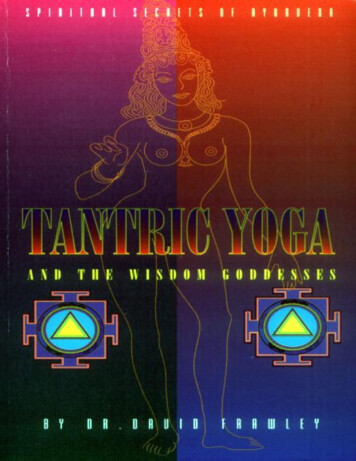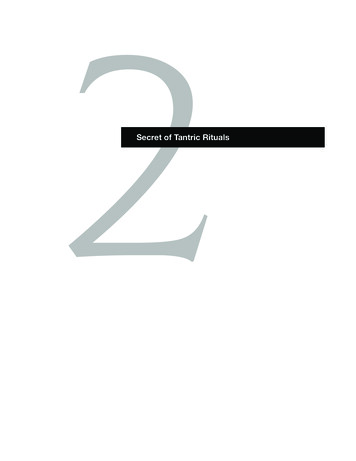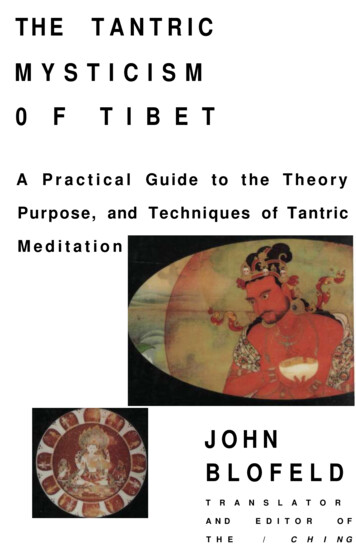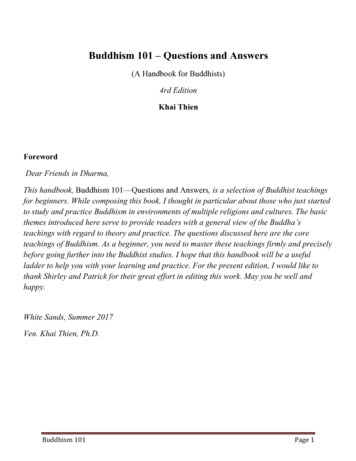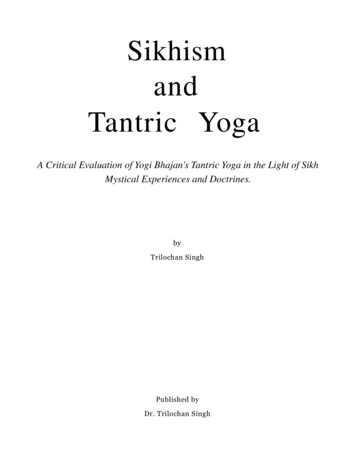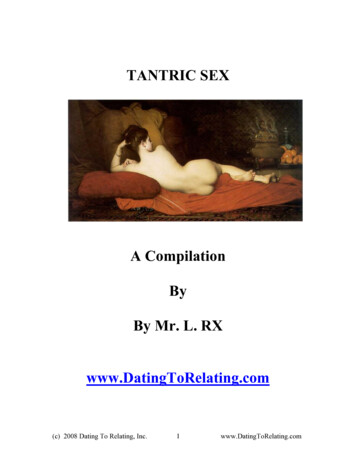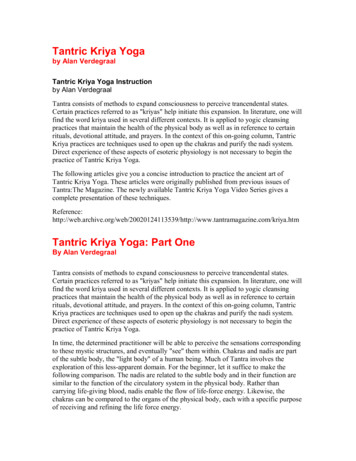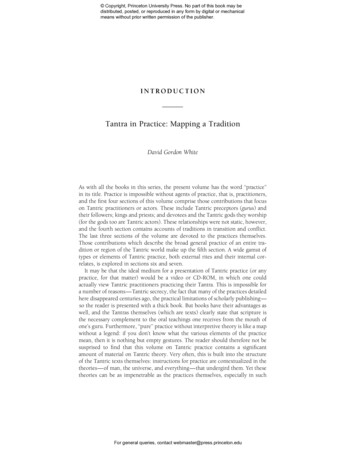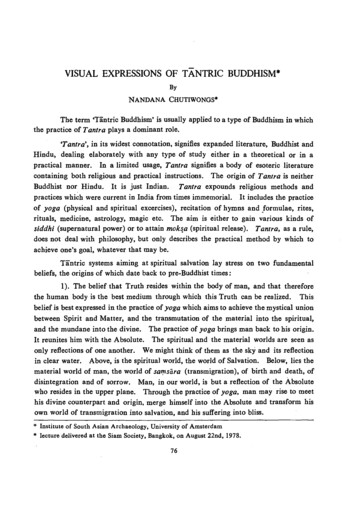
Transcription
VISUAL EXPRESSIONS OF TANTRIC BUDDHISM*ByNANDANA CHUTIWONGS*The term 'Tantric Buddhism' is usually applied to a type of Buddhism in whichthe practice of T antra plays a dominant role.'Tantra', in its widest connotation, signifies expanded literature, Buddhist andHindu, dealing elaborately with any type of study either in a theoretical or in apractical manner. In a limited usage, Tantra signifies a body of esoteric literaturecontaining both religious and practical instructions. The origin of Tantra is neitherBuddhist nor Hindu. It is just Indian. Tantra expounds religious methods andpractices which were current in India from times immemorial. It includes the practiceof yoga (physical and spiritual excercises), recitation of hymns and .formulae, rites,rituals, medicine, astrology, magic etc. The aim is either to gain various kinds ofsiddhi (supernatural power) or to attain moks,a (spiritual release). Tantra, as a rule,does not deal with philosophy, but only describes the practical method by which toachieve one's goal, whatever that may be.Tantric systems aiming at spiritual salvation lay stress on two fundamentalbeliefs, the origins of which date back to pre-Buddhist times:1). The belief that Truth resides within the body of man, and that thereforethe human body is the best medium through which this Truth can be realized. Thisbelief is best expressed in the practice of yoga which aims to achieve the mystical unionbetween Spirit and Matter, and the transmutation of the material into the spiritual,and the mundane into the divine. The practice of yoga brings man back to his origin.It reunites him with the Absolute. The spiritual and the material worlds are seen asonly reflections of one another. We might think of them as the sky and its reflectionin clear water. Above, is the spiritual world, the world of Salvation. Below, lies thematerial world of man, the world of saf!JSara (transmigration), of birth and death, ofdisintegration and of sorrow. Man, in our world, is but a reflection of the Absolutewho resides in the upper plane. Through the practice of yoga, man may rise to meethis divine counterpart and origin, merge himself into the Absolute and transform hisown world of transmigration into salvation, and his suffering into bliss.* Institute of South Asian Archaeology, University of Amsterdam* lecture delivered at the Siam Society, Bangkok, on August 22nd, 1978.76
VISUAL EXPRESSIONS OF TANTRIC BUDDHISM772) The concept of duality in non-duality or the concept of Two in One. Thereare two contrasting aspects in the fundamental nature of Reality: the static and thedynamic, the passive and the active, the negative and the positive. The realization ofthe Oneness of all pairs of opposites means final release or salvation, the ultimate goalof the practitioner.Buddhism in its later phases of development absorbed much of Tantric theoryand practice. In the Mahayana system, which represents the 'un-orthodox' form ofBuddhism, theological and philosophical speculations continually increased. Graduallybut steadily Mahayana Buddhism in India became affected by mysticism and otherancient Indian beliefs. As early as in the 4th-5th century A.D. certain Mahayanasects had already adopted the methods of yoga. And after Buddhism had onceadmitted certain elements of these ancient practices, all the remaining traditionalIndian beliefs in magic crept in. Eventually, out of this mixture of Buddhist traditionsand Tantric practices, which included all kinds of indigenous Indian elements such asesoteric yoga, mystic formulae, hymns, rituals, magic, sorcery and astrology, emergedTantric Buddhism.Mahayana Buddhism developed along two main trends: those of the Paramitayana (the Way of Perfection) and the Vajrayana or Tantrayiina (the Way of theThunderbolt or the Tantric Way). The latter is popularly known as Tantric Buddhism.The Paramitayana lays stress on paramita (perfection) as being the veryquality which will raise a Bodhisattva (a person seeking Enlightenment) to the stageof a Buddha. The Paramita Path requires absolute altruism, patience, perfection ofethics, moral, concentration and intelligence. In other words, it demands perfectionin every respect.The Vajrayana (or Tantrayana or Tantric Buddhism) expounds a short-cutpath towards Buddhahood: a quick and effective method with the aid of esotericpractices. This method is only instructed in secret because:l) it deals with the process of development which occurs in the innermostdepth of a man's being, a process so delicate and personal that it has to be carefullyguarded against all that might interfere with it.2) it is a path open only to superior individuals who have already gone throughthe 'common' paths, i.e. those of the Hinayana and Paramitayana.By havingundergone these 'lower' stages of studying the scriptures and of self-purification, theyhave built a solid foundation of Buddhist learning. Only on this foundation can theprocess of Tantra be added. A person without such a background is unsuitable toreceive Tantric instruction, because he is unable to understand its significance. By his
78Nandana Chutiwongslack of understanding he will devalue the instruction down to his own level or try tochange it into something it can never be.outcome.In such a case, disaster would be the onlyThe Tiintrio Way, therefore, is chiefly and basically meant for initiates. Itsmethods are instructed in secret by teachers to selected pupils. Non-initiates or personswho have not taken the Way seriously both with heart and soul, remain 'outsiders'.We all are outsiders. What is visible and comprehensible to us are mostly thingsbelonging to the most peripheral borders of the Tantric world. All that is essentialcannot be seen.Tantric Buddhism adheres to the two fundamental ideas of Tantra which havebeen described earlier, i.e. the belief in the transmutation of that which is imperfectinto that which is perfect, and the concept of the Oneness or Sameness of all pairs ofopposites. In addition to this, Tantric Buddhism also maintains much of the traditionalBuddhist concepts though it has its own way of interpreting and expressing them.The most important philosophical idea in Tantric Buddhism is the concept ofSiinyatii-an outstandingly important subject in Buddhist philosophy. Each Buddhistsystem has its own definition and interpretation of Siinyata, the literal meaning ofwhich is Void or Emptiness. Orthodox Buddhists regard it as being the very natureof the universe and of all its phenomena. The Mahayii.nists describes it as theAbsolute Truth, the One and Only Reality in the entire universe. Tantric Buddhismmaintains the general view of the Mahayana system and elaborates upon it. Siinyatain Tantric Buddhism is the Origin of all things. All forms, visible and invisible,mundane and divine, are but man festations of this Siinyatli and their true nature isthus nothing but Sunyata. Siinyata is comparable to a mirror which reflects all formsprojected upon it by the consciousness of each individual but contains no form in itself.This concept, therefore, permitted an unlimited expansion of the Taotric pantheonwhich eventually came to include deities of all descriptions. Each of them is believedto be an aspect of the Ultimate One.Equally important is the concept of Bodhicitta, meaning literally: a mindwhich is bent on Enlightenment. Un-orthodox Buddhists believe that every being inthe world is a potential Buddha, but that he will never be able to proceed towardsBuddhahood before he actually produces the Bodhicitta within himself.ThisBodhicitta, therefore, is equivalent to a vow, a resolution to attain Buddhahood.Upon becoming conscious of this Bodhicitta within himself, a Buddha-to-be willeventuaUy attain Buddhahood by progressing through the various stages of perfection
VISUAL EXPRESSIONS OF TANTRIC BUDDHISM79like a man mounting stairs reaches the top. But since he does not takes this vow forhimself but for the sake of all beings in the universe he possesses the two sublimequalities of Wisdom and Compassion. In Tantric Buddhist philosophy, where theconcept of Two in One predominates, Bodhicitta represents the union of these twoqualities which are essential for the attainment of Buddhahood. In a mind bent onEnlightenment, there must be Wisdom as well as Compassion.There must be apassive Realization of the Void as well as active Manifestations for the benefit of allbeings. The metaphysical union of these two principles may be brought about throughthe process of yoga. Remaining alone by itself the Bodhicitta is inactive, dull andslumbering, but through the practice of yoga the energies of Wisdom and Compassionflow into it, and awaken it to realize its sublime nature.In Tantric Buddhism there is also a strong belief in the power of chanting andrepeating mystical hymns, formulae and syllables. Such a belief, in fact, was alreadycurrent in India since the very beginning of her history, and it is also present amongthe so-called orthodox Buddhists. Nevertheless, these recitations of mantras or words,which are believed to contain mystical powers, are used extensively in Tantric Buddhism.The same may be said about mudras {mystic gestures) and the use of ma7Jrj.alas(diagrams). But these mystical formulae, gestures, as well as all the rites, rituals andceremonies of Tantric Buddhism are only to be regarded as instrumental in theattainment of one's spiritual release.The ultimate aim of Tantric Buddhism is nirva1Ja (the usual Buddhist term forSpiritual Release or Salvation), and this is to be obtained through the transmutation ofthat which is imperfect into that which is perfect, and through the transformation ofsar;nsara into nirviifJa and of a man into a Buddha, an Enlightened or Liberated One.All men, in fact, are already liberated.Each is already a Buddha but he himself doesnot realize it because of his own mental darkness and impurities.In the personalityof man there are such impure forces as Delusion, Hatred, Pride, Passion and Greed,which keep him forever bound to the round of transmigrations.These are strongforces lurking in his sub-consciousness, and they are capable of breaking through andoverwhelming his consciousness at any moment. They are irrepressible and becomeeven more dangerous and more powerful whenever they are suppressed or pushed back.They may by chance be restrained, but then only temporarily, and then only to burstout again stronger than ever. The only thing man can do to free himself from theseinherent evils is to purify them, to transform their destructive forces into benevolentenergies and direct these along the right channel towards the noble goal of Salvation.
80Nandana ChutiwongsTiintric Buddhism expounds practical methods for such a purification of manand his personality; quick and effective methods through which man may regain hislost perfection. This can be done through Tintric practice and Perfection, which isBuddhahood, can be regained now-in this life time. But the Tantric way is difficultand its training most severe.Initiation is most essential in the practice of Tantra. The Tantric way isdifficult and dangerous, so one needs the approval, guidance and supervision of ateacher at each step. In Tantric Buddhism there are four initiations corresponding tothe four grades of Tantra. Each initiation gives access to the practice of one particulartype of Tantra.The four grades of T antra are:1) Kriyatantra, dealing with instructions in rituals and exterior modes ofworship. It is specially meant for those who are inclined to rituals, and for those whoare slow in understanding and dull. This type of T antra will give them blessings andsome virtuous benefits, by which they may be able to purify themselves. But for thoseof higher intelligence, the first grade of T antra represents the opening of his eye ofwisdom.2) Caryatantra, dealing with ceremonies, religious excercises as well as withmeditation. It is described as suitable for fairly intelligent persons in whom a respectfor ceremony and devotion is accompanied by a capacity for deep thinking and seriousmeditation.3) Yogatantra4) AnuttarayogatantraThe first two are known as 'External Tantras'. The third and the fourthrepresent respectively a higher and the highest types of Tantras, known together as'Internal Tantras' or 'Esoteric Tantras'. The Yogatantra and Anuttarayogatantraare only for those of strong sensibility, those endowed with high intellectual powers,and capable of great good deeds as well as of great evil deeds. They contain instructions in meditational practice and very little in ritual, aiming primarily at the unityof all aspects of the One and Only Reality. This demands intensive meditation and aconstant focussing of the initiate's consciousness on that One Reality.By thispermanent realization of Truth, the transmutation of sa'?"siira into nirviif}a is complete.All that we as outsiders can see of Tantric Buddhism belongs to the two lowergrades, the External Tantras. Beyond these grades there are practically nothing to beseen or to be known. There are only things to be experienced, things which occur inthe depth of each initiate's mind and which will remain his own personal experience.
VISUAL EXPRESSIONS OF TANTRIC BUDDHISM81Nevertheless, almost all that we can see of Tiintric Buddhism, such as its richand complicated rituals, its images and textbooks containing instructions on rituals andon image-making-all that is essential in the first two grades of Tantras-involves theinstructions of the great Tantric masters of the past and of the present day. Theseinstructions are based on personal experiences of the masters and expressed in wordsor in forms comprehensible to their pupils. Images of deities which we see in paintingand sculpture, as well as their descriptions in ritual texts, are based on the visions ofthese great masters, captured in concrete or descriptive formS for the benefit of thosewho cannot see for themselves. These images represent the manifold forms in whichthe Absolute Reality or Siinyata manifested itself to the meditative masters, and arereproduced materially in lines, forms and colours visible to our eyes.The practice of the External Tantras requires external objects as instruments.Rituals purify the initiates and communicate to them the capacity to recei-ve thephysical and intellectual trainings that will follow.Images of deities play an important role both as objects of worship and asobjects of meditation. The deities whom they represent bear various forms and names,but they are only different reflections of the One Sunyata, displaying forms and coloursin accordance with various types of consciousnesses which have been reflected on themirror of Sunyata. Each image, each form, each deity represents one fragment, onetiny aspect of the Absolute, and one atom of the enormous energy which pervades theuniverse.These images especially serve the purpose of the practitioners of the Kriyatantraand Caryatantra. Simple devotees worship them to gain blessings, protection and goodfortune.By these worshippers, deities are evoked to manifest themselves in theimages, and are then praised with proper words and propitiated with proper rites.Special worship is directed towards a particular deity who has been chosen for eachpractitioner by his teacher. The teacher takes into consideration the character of thepupil, considers all signs and omens which have occurred during his process of initiation, and then assigns to each pupil an 'iJ[adevata' (chosen deity). For those beginnerswho are still bound to the convention of name and form, it is absolutely impossible toget into direct contact with the Ultimate Reality which is formless. Contact can begained only through the medium of names and forms, through an image and through aparticular deity who represents that Formlessness.· The nature of man is finite whilethe nature of the Absolute is infinite. Man never can grasp the Absolute Truth atonce in all its entirety, thus only one facet, one aspect, one part of it is chosen for himby his teacher as the means to bring him to that Reality. An intimate bond between
82Nandana Chutiwongsteacher and pupil, therefore, forms the very basis of Tintric training. The teacherknows his pupil, his background, his nature, his special merits, faults and weaknesses,and he wiii assign to the pupil that deity whose qualities and temperament wiii benefithim most. This i (adevata will be the pupil's guardian angel, his divine inspirationand source of power and success throughout his career. The deity wiii be what theinitiate takes him to be.He may be a divine protector for a soul inclined toworship and devotion, but for one who feels the urge to go beyond rituals and devotionsto discover the reality behind his existence, the i tadevata represents the way to therealization of that Truth.Every practitioner is entitled to an istvata To simple, uncomplicated peopleare assigned the less complex manifestations of the Absolute, i.e. sweet-naturedand compassionate deities who may be approached through love, humility and devotion.Figs. 1-4 show some of these gentle and benign aspects of the Absolute. To complicated, strong-minded and obstinate people capable of great good deeds as well of greatevil deeds, are assigned powerful, ferocious and sometimes even demonic deities (seeFigs. 6-9). The very obstacles which chain man to the cycle of birth and death are hisown imperfections, his own unwholesome traits. Thus be must learn to look at hisown faults straight in the eye. He must face the worst force within himself at itsworst, so that he may know its nature, origin, tendency and strength, as if he mustlearn to estimate the power of his worst enemy whom he must overcome. Fig. 6 showsan image of Hevajra, the personification of the evil sentiment of Hatred. This isHatred in its most monstrous form, Hatred at the zenith of its evil power. Hatred suchas one has to face if one wants to know it and overcome it. Fig. 7 is a configurationof Yama, the god of death, representing the inborn human fear of death in its mostterrifying form. One has to face one's own emotion, be it fear, hatred or passion, inthis way, when it is the zenith of its hideous power. Such a force cannot be annihilated.One can only overcome it by transforming it into something beneficial. This forcefulenergy, when purified, may be used to enable one to achieve one's goal. But the· Tantric methods which deal with the transformation of such forces are most dangerousfor untrained minds. A practitioner has to be strong enough before he begins to vokean evil power which may prove too strong for him. If he does not know how to dealwith it, he wiii be destroyed by it. If he is not pure enough to subdue this demon withhis purity, not advanced enough in spiritual training, this demon-his own uncontrolledemotion-will consume b1m like a fire. This is the reason why a practitioner will alwaysneed the careful and constant supervision of his teacher, who will estimate his mentalpower, prescribe the appropriate Way for him and see to it that no harm will befallhim.
VISUAL EXPRESSIONS OF TANTRIC BUDDHISM83Since everybody has his own chosen deity, uncountable images of gods andgoddesses have been made, each representing a particular aspect of the Absolute whois formless, either to be worshipped or to be meditated upon as a medium by which toreach Salvation.A person may worship as many deities as he chooses, but one ofthem is his own personal guardian, his guide towards Salvation, and his divinecounterpart with whom he will eventually merge and thereby regain his lost perfection-which is Buddhahood.Various types of deities are assigned to various types of practitioners. InTintric Buddhism we may come across images of all descriptions. There are sweet,benign deities like the goddess Sitatara (Fig. 1), the Great Mother and Protectress fromall dangers; .Maiijusri (Fig. 2) the Lord of Wisdom; the celestial Buddha Ratnasambhava (Fig. 3) who rules over the southern quarter of the universe, the element ofSensations and the particular emotion of Pride; and Amitabha (Fig. 4), the Buddha ofBoundless Light and Infinite Life, the overlord of the Western Paradise, Sukhavat'i, thedreamland of all senti nt beings.Then there are deities bearing fantastic forms, like the eleven-headed andthousand-armed Avalokitesvara (Fig. 5), the Watchful Saviour of our time, and theCompassionate Lord who looks over all directions of the universe and pronounces avow to save all beings from miseries.The most complicated images are those of forceful, ferocious deities likeHevajra (Fig. 6) and Yama (Fig. 7) whom we have mentioned earlier; Hayagriva(Fig. 8), the God with a Horse's head, a great dangerous demon to the weak, evil andunpurified mind but a powerful saviour to those who understand his nature; andYamantaka (Fig. 9), the ferocious manifestation of the God of Wisdom, a being mostterrifying in appearance, but to initiates he is the Conqueror of the fear of death andthe Destroyer of the evil darkness of Ignorance.Deities may be represented alone, or together with their female partner, orsurrounded by attendants. When a deity appears together with his partner, be is oftenseen in an intim3.te sex:ual union witlt lt r. Fig. 9 sh.J.v3 YJ. n1ntalca and !tis equallyterrifying partner, and in 'Fig. 10 we see the supreme Buddha Vajradhara and hisconsort locked in an intimate and loving embrace. Such a pair of god and goddesswhoever they are, wltatever form they may have and wltatever names may be given tothem-represent the concept of duality in non-duality, or Two in One. The AbsoluteReality is One, though it seems to possess two contrasting aspects. Such a pair of godand goddess stand for all pairs of opposites as known to us in our world of names andforms. All contrasting and opposite elements are meeting and melting together in
84Nandana Chutiwongstheir one and same origin: Sunyata. This is an image of saf!lsara as well as that ofWe see here a physical union of a man and a woman as well as the spiritualunity of the Self and the Not-Self, of man and all the rest of the universe. The forcenirvaf}a.which again and again turns the wheel of Creation, of birth and death, is the sameforce which may carry one to Salvation. This force used in a mundane way leads togeneration, procreation, multiplication, transmigration and disintegration. But thesame force, properly controlled and well directed, will lead to man's reintegration andthe return to the. sublime plane where he may regain his lost perfection and becomeone with the Absolute.In the Tantric world such a concept is also expressed by thepattern of a mystical triangle (see Fig. 11). This triangle, when its apex-its aspirationpoints downwards, means samsara or transmigration, the disintegration, the expansionfrom the One to the AlL But when its apex points upwards, it stands for the reintegration and the return of the All to the One.Then it represents nirvaiJa.Important and powerful deities often appear at the centre of maf!{falas, ormystical diagrams composed of figures, lines, patterns and colours (Pl. 12). In TantricBuddhism, a maf! ala is a diagram of the universe, a geometric projection of the worldreduced to an essential pattern,nirvaiJa.It unfolds the world of sa7]1sara as well as that ofOnce again we find the scheme of the disintegration from the One into theMany, and at the same time, that of the reintegration of the Many into the One.deity ix;' the centre of the maT}cjala is man himself as well as the Absolute.TheBy concen-trating his ind on the pattern of the maf! ala, by understanding "its composition inquiet contemplation,man re-discovers the way to reach his secret reality which is thesame as .that behind the entire universe. He re-discovers himself in the centre of hisown world in the. form of the all-comprehending deity in the centre of the ma1Jt/ala,the very point from which expansions and disintegration begin, but also the very pointwhere all names and forms, all lines and colours, all these disintegrations flow back andbecome re-absorbed. After this is clear to him, he will not need the mafJcfala-thisexternal object-any more, the whole structure of the universe and of his own existencewill shine clearly in his mind's eyes.Like the images· of deities, mamjalas serve the purpose of the ExternalTantras . . Like the images, they are objects of worship for those who are inclined toworship and rituals, repres nting shrines or residences of the gods. For those more'.inclined to meditation, they are objects of meditation and instruments for the realization of Truth through the medium of names and forms.
Fig.Sitatara. From D.I. Lauf, Tibetan Sacred Art, Berkeley & London, 1976,-pl.c34.
Fig. 2 Manjusri. Neg. Victoria & Albert Museum, London.
Fig. 3Ratnasambhava. From B.C. Olschak and Geshe Thupten Wangyal, Mystik und KunstAlttibets, Bern, 1972, pl. on p. 53.
Fig. 4Amitabha.From D.I. Lauf, Tibetan Sacred Art, pl. 46.
Fig. 5 Avalokitesvara. From A . Lommel, Kunst des Buddhismus, Zurich, 1974, pl. 99.
Fig. 6Hevaj ra. Neg. S. Leksukhum, Faculty of Archaeology, Silpakorn Universi ty.
Fig. 7.Yama. From J. van Goidsenhoven, Art Lama/que, art des dieux, Bruxelles,1970, pl. VI, 4.
Fig. 8 Hayagriva. From F. Sierksma, Tiber's Terrifying Deities, The Hague/Paris,1966, pl. 16.
ii : ·1· :11 Fig. 9Yamantaka and partner. From A. Lommel, Kunst des Buddhismus, pL 109.
Fig. 10Vajradhara and partner. From J. van Goidsenhoven, Art lamaique, art des dieux,pl. 1, 2.
F1g. 11Maf!tfala of Sarvabuddhagakini. From D. I. Lauf,' Tibetan Sacred Art,' pl. 54 .
Fig. 12Man tfala of Kiilacakra. From B.C . Olschak and Geshe Thupten Wangyal,Mystik und Kunst Alttibets, pl. on p. 111.
VISUAL EXPRESSIONS OF TANTRIC BUDDHISM85Beyond the stages of the Kriyatantra and Caryatantra, practically no externalobjects are needed in meditation. Instruction is given mainly on thought-creation andconcentration, till the Self and the Not-Self merge together permanently in Siinyata.What follows, is the sublime experience of Siinyata which no words can describe andno form can represent.Select Bibliography1) S.B. Dasgupta, An Introduction to Tantric Buddhism, repr; ep., Berkeley& London, 1974.2) B. Bhattacharyya, An Introduction to Buddhist Esoterism, ChowkhambaSanskrit Series, vol. XLVI, 2nd rev. ed., Varanasi, 1964.3) Tantra, Catalogue of an exhibition with Introduction by Ph. Rawson, ArtCouncil of Great Britain, London, 1971.4) H.V. Guenther, Treasures on the Tibeten M.iddle Way, 2nd ed.,1969. id n,5) F.D. Lessing and A. Wayman, Fundamentals of Buddhist Tantras, tran.;.slated from the Tibetan, Indo-Iranian Monographs, vol. VIII, The Hague,1968.6) G. Tucci, The Theory and Practice of the Mal'}4ala, London, 1961.7) D.L. Snellgrove, The Hevajra Tantra, a Critical Study, 2 parts, LondonOriental Series, vol. 6, repr. ed., London, 1971.
Tantric Buddhism. Mahayana Buddhism developed along two main trends: those of the Parami tayana (the Way of Perfection) and the Vajrayana or Tantrayiina (the Way of the Thunderbolt or the Tantric Way). The latter is popularly known as Tantric Buddhism. The Paramitayana lays stress on paramita (perfection) as being the very

